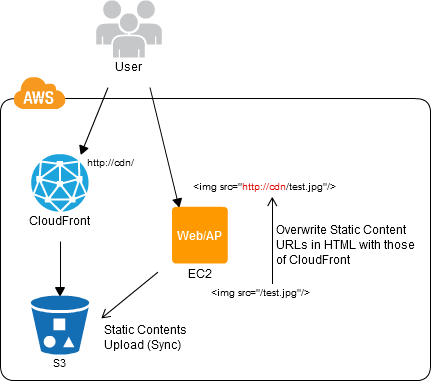CDP:URL Rewriting Pattern
Saving Static Content
Contents |
Problem to Be Solved
When a web service is provided by a virtual server, if the number of accesses becomes too large, the load is handled by increasing the number of virtual servers or upgrading the specifications of the virtual servers. However, often the majority of the accesses are requests for static content, so how to distribute access to static content has become an important issue.
Explanation of the Cloud Solution/Pattern
You can use Internet storage to distribute access of static content. This makes it possible to handle the load without increasing the number of virtual servers.
Using this method requires that the URL for the static content be changed to a URL for the Internet storage. But this does not imply that you always have to adjust the static content directly; you can use the the Filter function of the web server to change the URL at the time of delivery. Instead of delivering from Internet storage, you can also deliver the content from a content delivery server.
Implementation
In AWS, you can use the Amazon Simple Storage Service (S3) to deliver static content. You can deliver content globally without delay by using content located on Amazon Simple Storage Service (S3) as the original, and using the CloudFront content delivery service.
(Procedure)
- Upload (synchronize) a portion of the static content (JavaScript/CSS/images, etc.) of the EC2 to S3.
- If necessary, generate a CloudFront using, as the original, the S3 where the static content has been uploaded (synchronized). (When CloudFront is used, it is also possible to use an EC2 instance directly as the original server, rather than S3.)
- Overwrite the static content URLs in the HTML tags with those of the S3 or of CloudFront.
- You can use the Apache filter module or Nginx, prepared as a proxy, to perform the overwriting dynamically.
Configuration

Benefits
- You can provide greater robustness to load and can also reduce EC2 costs through distributing the access of static content to S3/CloudFront.
- You can use CloudFront as a way to handle latency caused by distance in worldwide delivery.
- When mod_ext_filter/mod_sed, Nginx, or the like is used, you can use this pattern by inserting a filter, without modifying the original HTML file. You can easily fall back to the state where CloudFront is not used, by simply turning the filter off.
Cautions
- When CloudFront is used, there may be some cases where deletion or updating may be delayed due to content caching.
